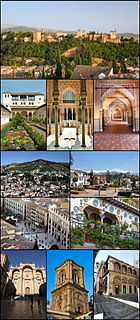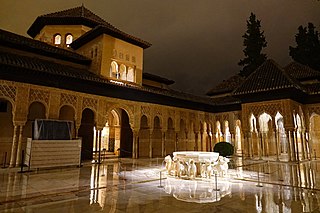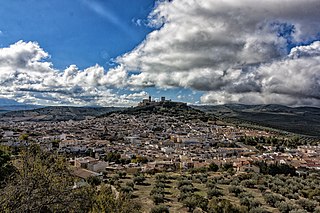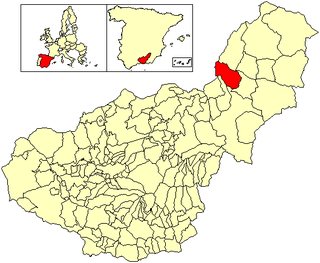
The Alhambra is a palace and fortress complex located in Granada, Andalusia, Spain. It was originally constructed as a small fortress in 889 CE on the remains of Roman fortifications, and then largely ignored until its ruins were renovated and rebuilt in the mid-13th century by the Arab Nasrid emir Mohammed ben Al-Ahmar of the Emirate of Granada, who built its current palace and walls. It was converted into a royal palace in 1333 by Yusuf I, Sultan of Granada. After the conclusion of the Christian Reconquista in 1492, the site became the Royal Court of Ferdinand and Isabella, and the palaces were partially altered in the Renaissance style. In 1526 Charles I & V commissioned a new Renaissance palace better befitting the Holy Roman Emperor in the revolutionary Mannerist style influenced by humanist philosophy in direct juxtaposition with the Nasrid Andalusian architecture, but it was ultimately never completed due to Morisco rebellions in Granada.

Granada, locally [ɡɾaˈna] is the capital city of the province of Granada, in the autonomous community of Andalusia, Spain. Granada is located at the foot of the Sierra Nevada mountains, at the confluence of four rivers, the Darro, the Genil, the Monachil and the Beiro. Ascribed to the Vega de Granada comarca, the city sits at an average elevation of 738 m (2,421 ft) above sea level, yet is only one hour by car from the Mediterranean coast, the Costa Tropical. Nearby is the Sierra Nevada Ski Station, where the FIS Alpine World Ski Championships 1996 were held.

The Court of the Lions (Spanish: Patio de los Leones; Arabic: بهو السباع) is the main courtyard of the Palace of the Lions in the heart of the Alhambra, the Moorish citadel formed by a complex of palaces, gardens and forts in Granada, Spain. It was commissioned by the Nasrid sultan Muhammed V of the Emirate of Granada in Al-Andalus. Its construction started in the second period of his reign, between 1362 and 1391 AD. The site is now part of the UNESCO World Heritage List and minted in Spain's 2011 limited edition of 2 € Commemorative Coins.

The Albaicín or Albayzín as it was known under Muslim rule, is a district of Granada, in the autonomous community of Andalusia, Spain. It retains the narrow winding streets of its Medieval Moorish past dating back to the Nasrid Kingdom of Granada. It was declared a World Heritage Site in 1984, along with the Alhambra.

The Palace of Charles V is a Renaissance building in Granada, southern Spain, located on the top of the hill of the Assabica, inside the Nasrid fortification of the Alhambra. The building has never been a home to a monarch and stood roofless until 1957.

The Archaeological Museum of Granada is an archaeological museum in the Albayzín district, Granada, Spain, established in 1879.

Aznalcázar is a town located in the province of Seville, southern Spain. It is only 20 minutes away from Seville, and is one of the 13 towns located in Doñana National Park, one of Spain's most important national parks and wildlife reserves.

Alcalá la Real is a city in the province of Jaén, Spain. According to the 2006 census (INE), the city has a population of 22,129 inhabitants.

Castril, former Castril de la Peña, is a municipality located in the province of Granada, Spain.

Cortes de Baza is a municipality located in the province of Granada, Spain. According to the 2005 census (INE), the city has a population of 2335 inhabitants.

Dúrcal with a population of 7,286 (2012) is a Spanish municipality located in the north-eastern part of the Valle de Lecrín in the Province of Granada, in the autonomous community of Andalusia, one of the 51 entities that make up the metropolitan area of Granada. It borders the municipalities of Dílar, Lanjaron, Nigüelas, Villamena, and the Padul. Other nearby towns are Padul and Mondújar. The council consists of durqueño nuclei Dúrcal, which is the capital district Lecrín Valley, and Marchena. Much of its township is located in the Sierra Nevada National Park.

Víznar is a municipality located in the province of Granada, Spain, only a few miles from the city of Granada itself. According to the 2005 census (INE), the town has a population of 789 inhabitants.

The Emirate of Granada, also known as the Nasrid Kingdom of Granada, was an Islamic realm in southern Iberia during the Late Middle Ages. It was the last independent Muslim state in Western Europe.

The School of Arabic Studies is a research Institute of the Spanish National Research Council with headquarters at the Houses of the Chapiz in Granada.

The Lebrija Palace or Palacio de la Condesa de Lebrija is a house-museum in central Seville, Spain. Dating to the 16th century and remodeled between the 18th and 20th centuries, the palace is characterised by its collection of art, including Roman mosaics and other antiquities as well as Asian art, paintings by European masters and European decorative arts.

The Gate of the Pomegranates is an historical access point of a pathway that leads through the Forest of the Alhambra to the Nasrid palace that is the Alhambra, located in the city of Granada, Spain. The path starts in the city centre, Plaza Nueva, and continues up the Cuesta de Gomérez, before reaching the monument.

Castillo de Vélez-Blanco is a remarkable example of Spanish Renaissance Castle. It is located in the town of Vélez-Blanco, province of Almería, in the autonomous community of Andalusia, Spain.

The Museo de Bellas Artes de Granada is a fine arts museum in Granada, Spain. Since the 1950s it has been housed in the Palace of Charles V which also houses the Museo de la Alhambra.

The Palacio de los Olvidados is a museum in Granada, Spain, dedicated to Inquisition. The museum has a selection of the instruments most used by different inquisitorial, ecclesiastical and civil courts, throughout Europe for torture, public humiliation and capital punishment. This palace also has an exhibition of Interactive Flamenco. With this exhibition you can discover the whole world of flameco in an exclusive space specially designed to experience the different sensations that this art can offer.

The Maristan of Granada was a bimaristan (hospital) in Granada, Spain. It was built in the 14th century and demolished in the 19th century.



















